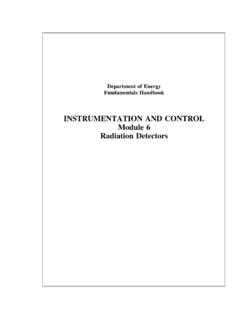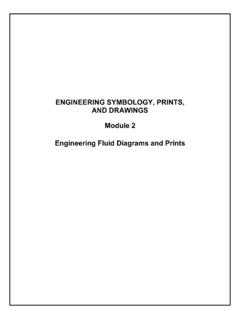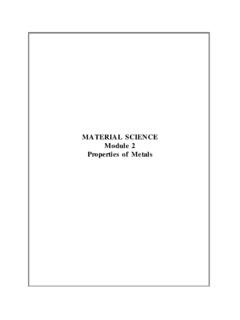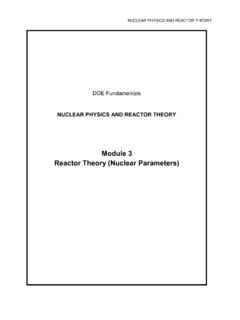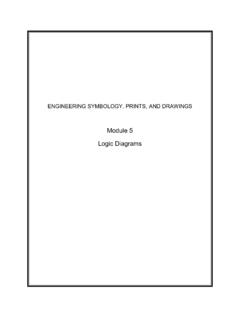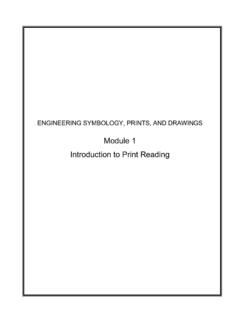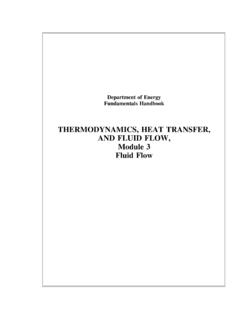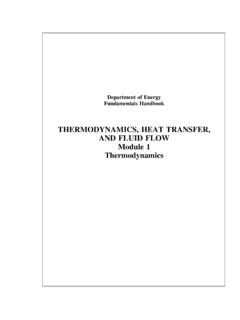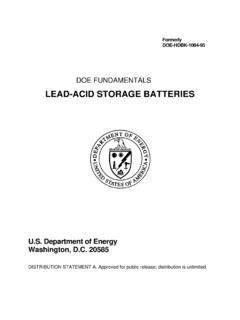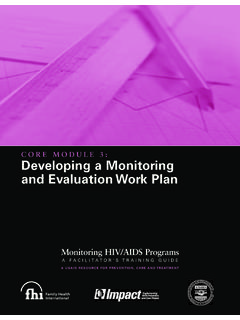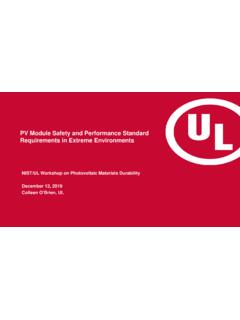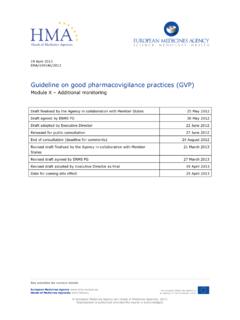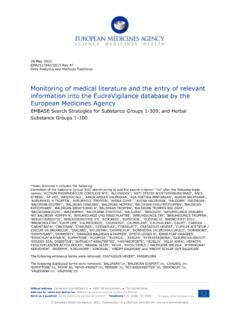Transcription of Module 2: Reactor Theory (Neutron Characteristics) - Energy
1 DOE Fundamentals NUCLEAR PHYSICS AND Reactor Theory Module 2: Reactor Theory (Neutron Characteristics) NUCLEAR PHYSICS AND Reactor Theory 2-i TABLE OF CONTENTS T able of Co nte nts TABLE OF CONTENTS .. i LIST OF FIGURES .. iii LIST OF TABLES ..iv REFERENCES .. v OBJECTIVES ..vi NEUTRON SOURCES .. 1 Neutron Sources .. 1 Intrinsic Neutron Sources .. 1 Installed Neutron Sources .. 3 4 NUCLEAR CROSS SECTIONS AND NEUTRON FLUX .. 5 Introduction .. 6 Atom Density .. 6 Cross Sections .. 7 Mean Free Path .. 10 Calculation of Macroscopic Cross Section and Mean Free Path.
2 10 Effects of Temperature on Cross Section .. 14 Neutron Flux .. 15 Self-Shielding .. 16 16 REACTION RATES .. 18 Reaction Rates .. 18 Reactor Power 20 Relationship Between Neutron Flux and Reactor Power .. 21 22 NEUTRON MODERATION .. 23 Neutron Slowing Down and Thermalization .. 23 Macroscopic Slowing Down Power .. 26 Moderating Ratio .. 26 27 PROMPT AND DELAYED NEUTRONS .. 28 Neutron Classification .. 28 NUCLEAR PHYSICS AND Reactor Theory 2-ii Neutron Generation 29 30 NEUTRON FLUX SPECTRUM .. 32 Prompt Neutron 32 Thermal and Fast Breeder Reactor Neutron Spectra.
3 33 Most Probable Neutron Velocities .. 34 35 NUCLEAR PHYSICS AND Reactor Theory 2-iii LIST OF FIGURES Figure 1 Typical Neutron Absorption Cross Section vs. Neutron Energy .. 9 Figure 2 Prompt Fission Neutron Energy Spectrum for Thermal Fission of Uranium-235 .. 32 Figure 3 Comparison of Neutron Flux Spectra for Thermal and Fast Breeder Reactor .. 33 NUCLEAR PHYSICS AND Reactor Theory 2-iv LIST OF TABLES Table 1 Neutron Production by Spontaneous Fission .. 2 Table 2 Moderating Properties of Materials .. 26 Table 3 Delayed Neutron Precursor Groups for Thermal Fission in Uranium-235.
4 29 NUCLEAR PHYSICS AND Reactor Theory 2-v REFERENCES Foster, Arthur R. and Wright, Robert L. Jr., Basic Nuclear Engineering, 4th Edition, Allyn and Bacon, Inc., 1983. Jacobs, , Kline, , and Remick, , Basic Principles of Nuclear Science and Reactors, Van Nostrand Company, Inc., 1960. Kaplan, Irving, Nuclear Physics, 2nd Edition, Addison-Wesley Company, 1962. Knief, Ronald Allen, Nuclear Engineering: Theory and Practice of Commercial Nuclear Power, 2nd Edition, McGraw-Hill, 1992. Lamarsh, John R., Introduction to Nuclear Engineering, 3rd Edition, Addison-Wesley Company, 2001.
5 Lamarsh, John R., Introduction to Nuclear Reactor Theory , American Nuclear Society, 2002. Knolls Atomic Power Lab, Nuclides and Isotopes: Chart of the Nuclides, 17th Edition, Knolls Atomic Power Lab, 2010. Academic Program for Nuclear Power Plant Personnel, Volume III, Columbia, MD, General Physics Corporation, Library of Congress Card #A 326517, 1982. Glasstone, Samuel, Sourcebook on Atomic Energy , 3rd Edition, Robert F. Krieger Publishing Company, Inc., 1979. Glasstone, Samuel and Sesonske, Alexander, Nuclear Reactor Engineering, 4th Edition, Van Nostrand Reinhold Company, 1994.
6 NUCLEAR PHYSICS AND Reactor Theory 2-vi OBJECTIVES TERMINAL OBJECTIVE Without references, EXPLAIN how neutron sources produce neutrons. ENABLING OBJECTIVES DEFINE the following terms: a. Intrinsic neutron source b. Installed neutron source LIST three examples of reactions that produce neutrons in intrinsic neutron sources. LIST three examples of reactions that produce neutrons in installed neutron sources. TERMINAL OBJECTIVE Given the necessary information for calculations, EXPLAIN basic concepts in Reactor physics and perform calculations. ENABLING OBJECTIVES DEFINE the following terms: a.
7 Atom density d. Barn b. Neutron flux e. Macroscopic cross section c. Microscopic cross section f. Mean free path EXPRESS macroscopic cross section in terms of microscopic cross section. DESCRIBE how the absorption cross section of typical nuclides varies with neutron Energy at energies below the resonance absorption region. DESCRIBE the cause of resonance absorption in terms of nuclear Energy levels. DESCRIBE the Energy dependence of resonance absorption peaks for typical light and heavy nuclei. EXPRESS mean free path in terms of macroscopic cross section.
8 Given the number densities (or total density and component fractions) and microscopic cross sections of components, CALCULATE the macroscopic cross section for a mixture. CALCULATE a macroscopic cross section given a material density, atomic mass, and microscopic cross section. NUCLEAR PHYSICS AND Reactor Theory 2-vii EXPLAIN neutron shadowing or self-shielding. Given the neutron flux and macroscopic cross section, CALCULATE the reaction rate. DESCRIBE the relationship between neutron flux and Reactor power. DEFINE the following concepts: a. Thermalization d.
9 Average logarithmic Energy decrement b. Moderator e. Macroscopic slowing down power c. Moderating ratio LIST three desirable characteristics of a moderator. Given an average fractional Energy loss per collision, CALCULATE the Energy loss after a specified number of collisions. TERMINAL OBJECTIVE Without references, EXPLAIN the production process and effects on fission of prompt and delayed neutrons. ENABLING OBJECTIVES STATE the origin of prompt neutrons and delayed neutrons. STATE the approximate fraction of neutrons that are born as delayed neutrons from the fission of the following nuclear fuels: a.
10 Uranium-235 b. Plutonium-239 EXPLAIN the mechanism for production of delayed neutrons. EXPLAIN prompt and delayed neutron generation times. Given prompt and delayed neutron generation times and delayed neutron fraction, CALCULATE the average generation time. EXPLAIN the effect of delayed neutrons on Reactor control. TERMINAL OBJECTIVE Without references, DESCRIBE the neutron Energy spectrum for the type of Reactor presented in this Module . ENABLING OBJECTIVES STATE the average Energy at which prompt neutrons are produced. NUCLEAR PHYSICS AND Reactor Theory 2-viii DESCRIBE the neutron Energy spectrum in the following reactors: a.
